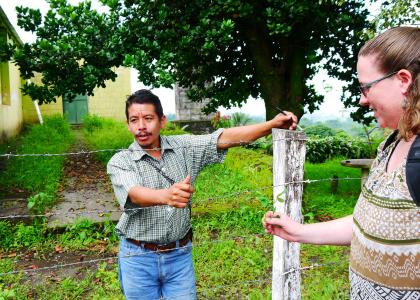CIAT (Household time-use)
International Center for Tropical Agriculture (CIAT)
His and Hers, time and income: How intra-household dynamics impact nutrition in agricultural households

PI: Jennifer Twyman
Partners: Pilar Useche (University of Florida), Carolina Gonzalez (CIAT), Elise Talsma (CIAT), Diana Carolina Lopera (CIAT)
Start date: 1 January 2017
Duration: 24 months
Value: £249,984
Countries of research: Guatemala

Summary of the project
Despite recent advances in nutrition and food security, these issues still represent a challenge in developing countries since consuming an adequate diet is not yet something affordable for many people.
Pathways to improved nutrition
Firstly, one of the paths from agriculture to nutrition requires changes in family income - an increase in income improves nutrition while allowing people to buy healthier foods.
Secondly, time allocation must be taken into account when considering nutrition issues - by transferring time allocation from food preparation to income generating or other productive activities, families tend to buy less healthy foods that save time, being more convenient in the short run, but leading to worsening their nutrition.
Thirdly, gender issues must also be considered. Women are often expected to stay at home preparing food and fulfilling caregiving responsibilities, while men carry out income generating and other productive responsibilities in the household. While more and more women are acquiring income-earning jobs, they are often still expected to fulfill the care giving roles in the household, including preparing foods. These cultural gender norms influence time allocation decisions and have implications on nutrition.
To address the points mentioned above, it is necessary to include women in agricultural projects. Likewise, it is also important to include men in nutrition projects and improve their understanding of the decision-making around food consumption and nutrition.
Main objectives of the project
- To understand the determining factors in the decision-making processes in households regarding food consumption and dietary diversity, and how these decisions are affected by changes in income
- To analyze if households where women have more decision-making power (in terms of time and budget allocation for food) differ in their consumption patterns compared to households in which men make most decisions.
Methodology
- Surveys (at household and intra-household level) that seek to inquire about decision making within households and their characteristics, time allocation and food consumption
- Choice experiments that aim to understand the link between gender norms, time allocation, and decision making regarding food consumption in the household
- Choice experiments also intended to contrast decision making in food selection for men and women individually and jointly under different scenarios (hypothetical and real).
Expectations
Through this project we hope to better understand:
- How decisions are made around food consumption and what is the role of men and women
- Whether individual preferences of men and women dominate decisions in their households
- Gender dimensions regarding time allocation, and how nutrition is affected at the household level
- Likewise, we expect that the information collected will be used to design nutrition programs and policies that promote better nutrition in rural families.

